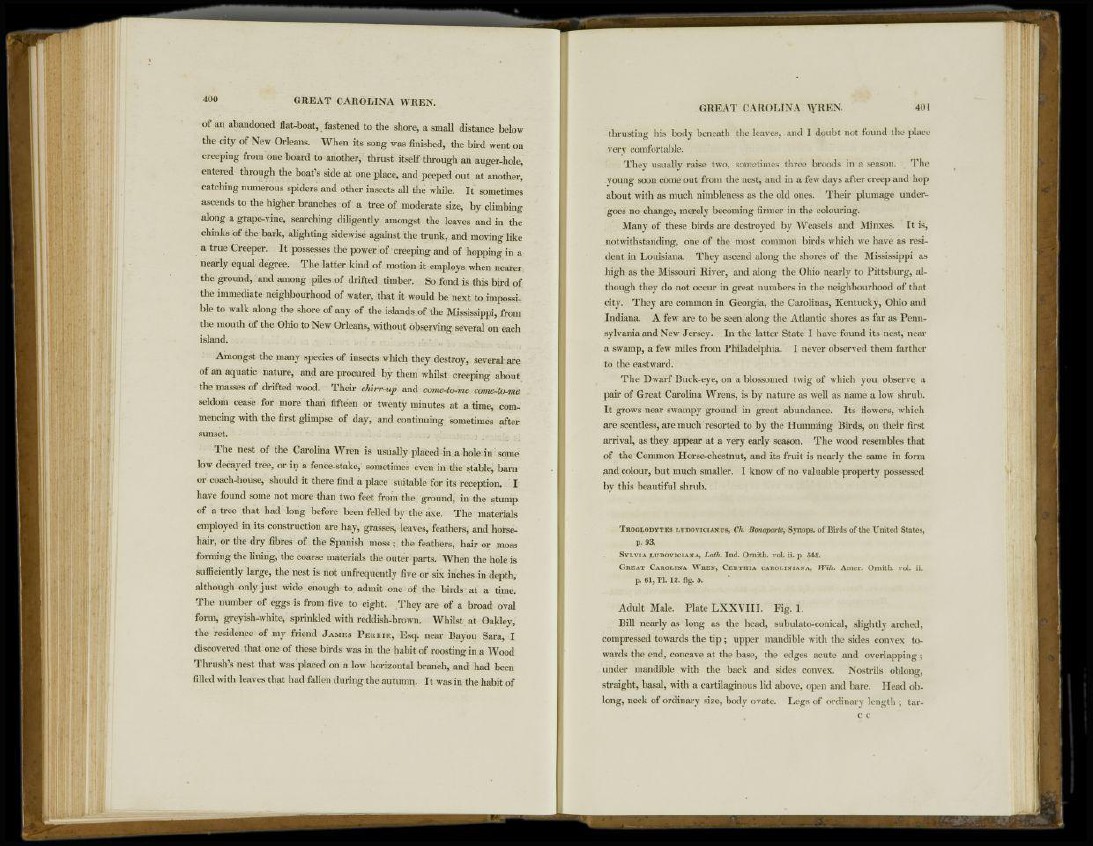
400 GREAT CAROLINA WREN.
of an abandoned flat-boat, fastened to the shore, a small distance below
the city of New Orleans. When its song was finished, the bird went on
creeping from one board to another, thrust itself through an auger-hole,
entered through the boat's side at one place, and peeped out at another,
catching numerous spiders and other insects all the while. It sometimes
ascends to the higher branches of a tree of moderate size, by climbing
along a grape-vine, searching diligently amongst the leaves and in the
chinks of the bark, alighting sidewise against the trunk, and moving like
a true Creeper. It possesses the power of creeping and of hopping in a
nearly equal degree. The latter kind of motion it employs when nearer
the ground, and among piles of drifted timber. So fond is this bird of
the immediate neighbourhood of water, that it would be next to impossible
to walk along the shore of any of the islands of the Mississippi, from
the mouth of the Ohio to New Orleans, without observing several on each
island.
Amongst the many species of insects which they destroy, several are
of an aquatic nature, and are procured by them whilst creeping about
the masses of drifted wood. Their chirr-up and come-to-me come-to-me
seldom cease for more than fifteen or twenty minutes at a time, commencing
with the first glimpse of day, and continuing sometimes after
sunset.
The nest of the Carolina Wren is usually placed in a hole in some
low decayed tree, or in a fence-stake, sometimes even in the stable, barn
or coach-house, should it there find a place suitable for its reception. I
have found some not more than two feet from the ground, in the stump
of a tree that had long before been felled by the axe. The materials
employed in its construction are hay, grasses, leaves, feathers, and horsehair,
or the dry fibres of the Spanish moss ; the feathers, hair or moss
forming the lining, the coarse materials the outer parts. When the hole is
sufficiently large, the nest is not unfrequently five or six inches in depth,
although only just wide enough to admit one of the birds at a time.
The number of eggs is from five to eight. They are of a broad oval
form, greyish-white, sprinkled with reddish-brown. Whilst at Oakley,
the residence of my friend JAMES PEIIRIE, Esq. near Bayou Sara, I
discovered that one of these birds was in the habit of roosting in a Wood
Thrush's nest that was placed on a low horizontal branch, and had been
filled with leaves that had fallen during the autumn. It was in the habit of
thrusting his body beneath the leaves, and I doubt not found the place
very comfortable.
They usually raise two, sometimes three broods in a season. The
young soon come out from the nest, and in a few days after creep and hop
about with as much nimbleness as the old ones. Their plumage undergoes
no change, merely becoming firmer in the colouring.
Many of these birds are destroyed by Weasels and Minxes. It is,
notwithstanding, one of the most common birds which we have as resident
in Louisiana. They ascend along the shores of the Mississippi as
high as the Missouri River, and along the Ohio nearly to Pittsburg, although
they do not occur in great numbers in the neighbourhood of that
city. They are common in Georgia, the Carolinas, Kentucky, Ohio and
Indiana. A few are to be seen along the Atlantic shores as far as Pennsylvania
and New Jersey. In the latter State I have found its nest, near
a swamp, a few miles from Philadelphia. I never observed them farther
to the eastward.
The Dwarf Buck-eye, on a blossomed twig of which you observe a
pair of Great Carolina Wrens, is by nature as well as name a low shrub.
It grows near swampy ground in great abundance. Its flowers, which
are scentless, are much resorted to by the Humming Birds, on their first
arrival, as they appear at a very early season. The wood resembles that
of the Common Horse-chestnut, and its fruit is nearly the same in form
and colour, but much smaller. I know of no valuable property possessed
by this beautiful shrub.
TROGLODYTES LUDOVICIANUS, Ck. Bonaparte, Synops. of Birds of the United States,
p. 93.
SYLVIA LUDOVICIANA, Lath. Ind. Ornith. vol. ii. p 548.
GREAT CAROLINA WREN, CERTHIA CAROI.INIANA, Wils. Amer. Ornith. vol. ii.
p. 61, PI. 12. fig. 5.
Adult Male. Plate LXXVIII. Fig. 1.
Bill nearly as long as the head, subulato-conical, slightly arched,
compressed towards the tip ; upper mandible with the sides convex towards
the end, concave at the base, the edges acute and overlapping ;
under mandible with the back and sides convex. Nostrils oblong,
straight, basal, with a cartilaginous lid above, open and bare. Head oblong,
neck of ordinary size, body ovate. Legs of ordinary length ; tarc
c